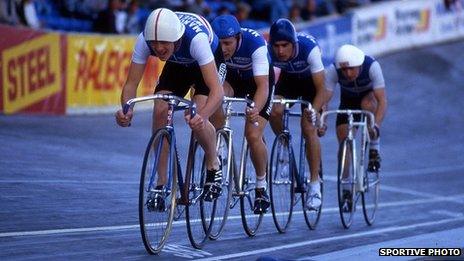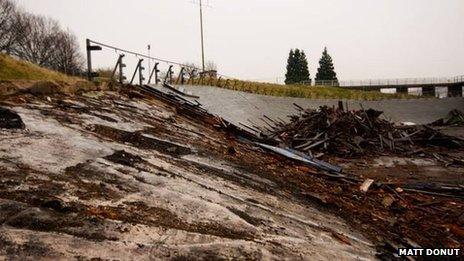Leicester and Derby: A tale of two velodromes
- Published
.jpg)
Leicester's Saffron Lane Velodrome fell into disrepair before being demolished in 2008
In places, the gaps between the wooden tracks were as wide as bicycle wheels - and between races a man sometimes needed to nail down the loose boards - but Saffron Lane Velodrome is sorely missed.
In its heyday, the Leicester venue was at the centre of British cycling and the scene of Olympic gold medallist Chris Boardman's first world record.
Unfortunately, the English weather and a lack of investment took their toll on the 3,100-seat outdoor track.
It closed in 1999, and some are still bitter that such a magnet for cycling enthusiasts was allowed to slip out of the Midlands' grasp.
But work has now begun on an ambitious new velodrome in nearby Derby, raising hopes that the region could once again become a hub for the sport.
So can the new multi-million project recapture the glory of the past without repeating its mistakes?
'Too expensive to maintain'
In many ways, Saffron Lane was a success story which will be hard to follow.
For 20 years it was the national velodrome and twice hosted the UCI World Championships - in 1970 and 1982.
So what went wrong?
The beginning of the end for Saffron Lane came in 1994 when the country's first indoor velodrome was built in Manchester, and the national championships moved to the North West.

Leicester's Saffron Lane Velodrome, which opened in 1968, was once the country's national cycling stadium.

Olympic gold medallist Chris Boardman had a long association with the stadium, competing there as a youngster in the 1980s.

The Saffron Lane track was demolished in 2008 after falling into disrepair.
.jpg)
It is hoped Derby's new velodrome will give the region a world class cycling venue once again.
Bryan Steel, who was part of Team GB's Olympic sprint team at Athens in 2004 raced at Saffron Lane for about 10 years.
"Leicester was really important to me," he said.
"[But] the big downfall for Saffron Lane was that it didn't have a roof and when it rains you can't ride a wooden track, it was as simple as that."
With the stadium open to the elements, the track expanded and contracted, causing gaps to appear on the surface. It proved too costly to maintain, was abandoned in 1999, and controversially demolished in 2008.
Cycling historian Roger Lovell said the loss of the 1968-built stadium was a "crying shame" and believes the council could have used it as a community facility with a bit of investment.
"Cyclists from all over the world loved the atmosphere of Leicester, they loved competing here. It was the UK's cycling capital," he said.
"I share the anger and disappointment [that the stadium has gone], and with some imagination it could have remained here. It would have been a great central venue for all things cycling in Leicester."
Leicester City Council razed the derelict velodrome to make way for development rather than making the track useable again.
The authority said the cost of a new, covered track was beyond its finances and because the site had fallen victim to vandalism, graffiti, drug taking and arson, it was safer to knock it down.
Chris Boardman, who won gold at the Barcelona games in 1992, said he spent many happy hours at Saffron Lane but admits he can see both sides of the argument.
"It's not always easy to balance everything your community wants from you," he said.
"But from a purely cyclist's point of view it's a real shame that we lost it."
The former Tour de France rider said the stadium "missed the window" when it came to cycling's popularity post-London 2012.
"If it had managed to hang on for another decade it would have possibly been celebrated as an historic structure," he said.
In December, four years since the track's demolition, Leicester City Council announced the sale of the land.
Work on a social housing development will begin in January.
'Rush of enthusiasm'
Perhaps understandably, the focus in neighbouring Derby is very much on creating a velodrome with broad appeal and longevity.
Due to be completed by the end of 2014, the UK's sixth indoor cycling track was recently given the green light - though supporters of the project had an early scare.
When the Conservative/Lib Dem coalition lost control of Derby City Council in May, Labour ordered a report into the benefits of the 5,000-seat sports centre.
In response, cyclists - alarmed that the scheme might have been close to collapse - rallied in Derby's market place.
-1.jpg)
The Derby velodrome will have facilities for badminton and basketball
City councillor Martin Repton, head of leisure and culture, argued the project was too expensive to commit to without further checking.
"It was important in these economic times that we made sure it was the right thing for Derby, and it was what people wanted," he said.
"There had been a rush of enthusiasm, which we shared, but it needed to be matched by proper due diligence. There were still unresolved issues."
Negotiations had to take place with Pride Park stadium, the nearby home of Derby County, as well as the National Grid and the Environment Agency - as the location was a former landfill site.
Work has now begun but Mr Repton is keen to stress that the stadium will not be used just for cycling.
A space for basketball, badminton and netball will also be included - and the arena will be used for music concerts too.
"We could keep spending money patching up 40-year-old leisure centres," said the councillor.
"We thought it would be better to build a brand new sports centre that's inclusive for everyone."
Despite Derby's place at the heart of the Midlands, can the UK sustain another with indoor cycling centres in Wales, Scotland, and in the north and south of England?
"It's an interesting question," said British Cycling's education director John Mills.
"We've had phenomenal success at the Olympic games based on one velodrome [in Manchester] but imagine what we can do with five?"
Chris Boardman is more cautious about the prospect.
"[Cycling at a velodrome] is a specific thing and we'll have to see as we go along. Are people going to stop going to one to start going to the other?
"We don't know where it's going to go but it's not a bad thing for cycling."
- Published6 December 2012
- Published22 November 2012
- Published28 August 2012
- Published28 June 2012
- Published12 July 2012